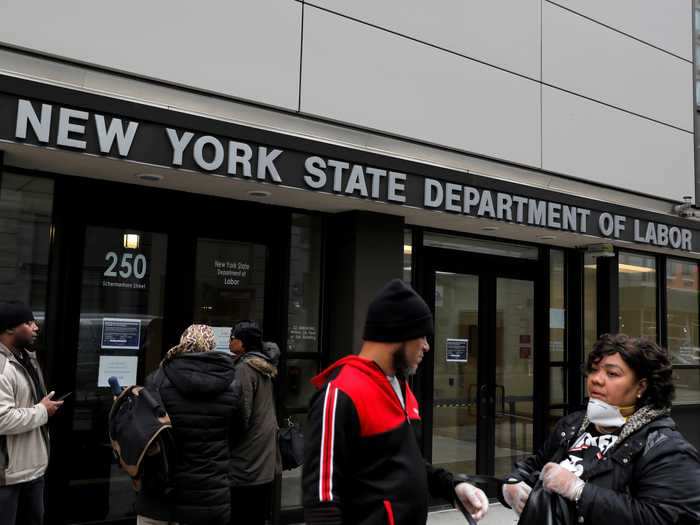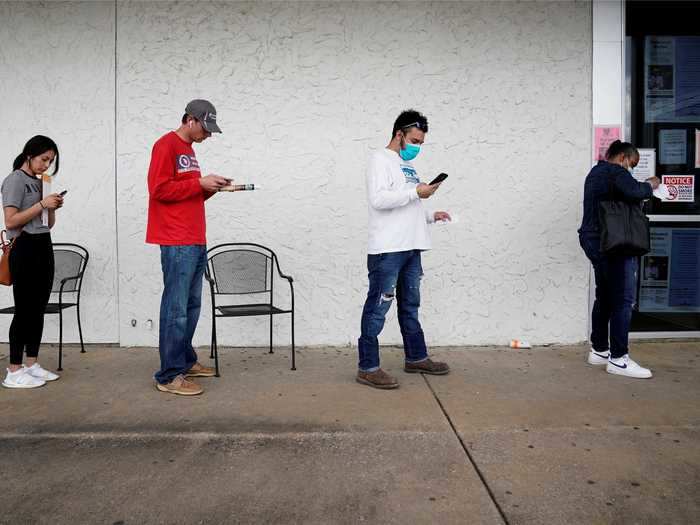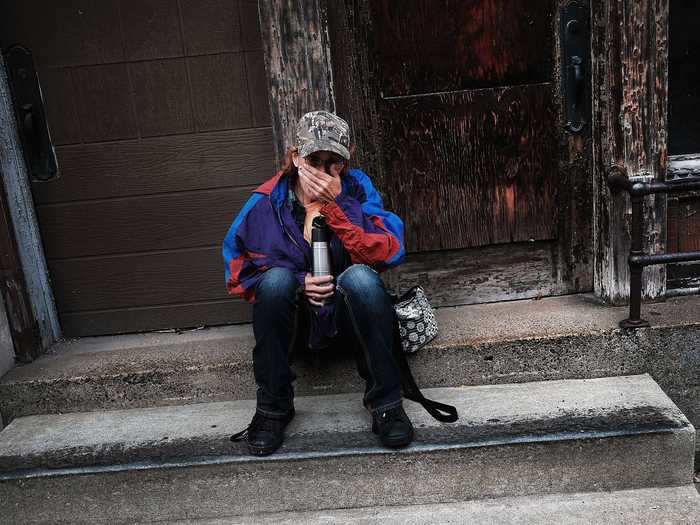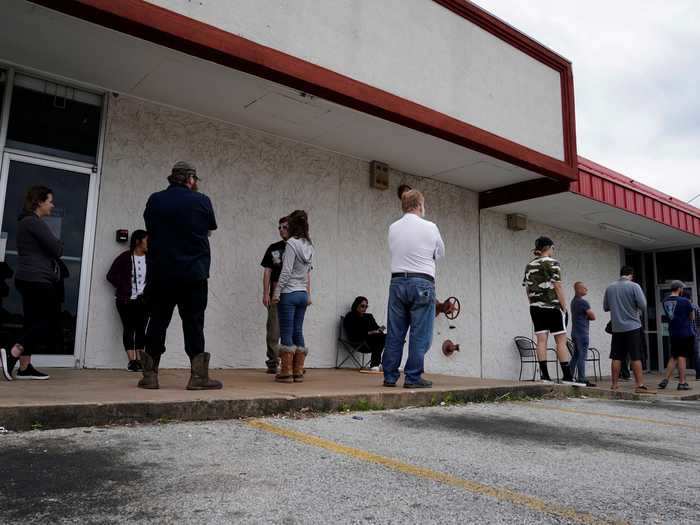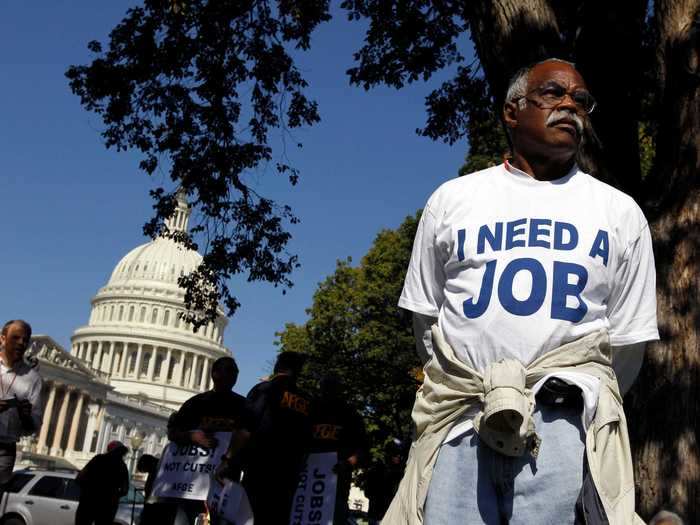A masked worker at this state WIN job center in Pearl, Miss., holds an unemployment benefit application form as she waits for a client, Tuesday, April 21, 2020. The job centers lobbies are closed statewide to prevent the spread of COVID-19. However the continuing growth of unemployment demands and now additional assistance for self-employed, church employees, gig workers, and others who were previously ineligible for unemployment assistance has drawn some people to the centers for information and to obtain and submit unemployment benefit applications. (AP Photo/Rogelio V. Solis)Associated Press
- On Thursday, the Labor Department released its weekly jobless claims report, showing 4.4 million Americans filed for unemployment in the week ending April 18.
- In the last five weeks, 26 million Americans have lost jobs and filed for unemployment benefits as economic fallout from the coronavirus pandemic continues.
- Here's what five economists said following Thursday's weekly jobless claims report.
- Visit Business Insider's homepage for more stories.
In the last five weeks, 26 million Americans have filed for unemployment claims as layoffs persist amid the coronavirus pandemic.
While the latest report showed a third weekly decline since jobless claims peaked at nearly 7 million in the last week of March, the continued elevated losses are staggering. Cumulative claims in the last five weeks are roughly equivalent to filings between January and October 2009, the worst 10 months of the Great Recession.
"At this stage, the signs are not promising," Seema Shah, chief strategist at Principal Global Investors, told Business Insider. While initial claims have declined from the peak, continuing claims are still growing, showing that people remain out of work despite support from the US government, she said.
Read more: The CEO of a $29 billion asset manager who's steered his firm since 9/11 told us why pessimism about the coronavirus crisis is overblown — and shared 3 stock picks for a new normal in healthcare
How long people remain out of work is where much of the focus will be from now on, according to Shah. "The more unemployment rises, the slower the eventual recovery may be," she said.
Going forward, economists will continue to monitor weekly jobless claims as they provide one of the best snapshots of what's currently happening in the US economy. In addition, all eyes will be on the April jobs report, released in early May. That report is expected to show a huge spike in the unemployment rate, reflecting the worst weeks of jobless claims from the coronavirus pandemic.
Here's what five economists said about Thursday's weekly jobless claims report:
Read the original article on
Business Insider
5. Economic Policy Institute: The unemployment rate "will likely not reflect all coronavirus-related layoffs"
People gather at the entrance for the New York State Department of Labor offices on March 20, which closed to the public due to the coronavirus outbreak in the Brooklyn borough of New York City.
Andrew Kelly/Reuters
"All else equal, job losses of this magnitude would translate into an unemployment rate of 18.3%," Heidi Shierholz, senior economist at the Economic Policy Institute, wrote in a note Thursday.
"However, the official unemployment rate, when it is released, will likely not reflect all coronavirus-related layoffs," she said, adding this is because jobless workers are counted only as unemployed if they are actively seeking work.
She continued: "The UI claims of the last five weeks, while extraordinary, don't even include most people who aren't eligible for regular UI but are nevertheless out of work due to the virus—people like gig workers or independent contractors, and many others."
4. ING: "Less than half of the working age population of America will be earning a wage by May"
FILE PHOTO: The spread of the coronavirus disease (COVID-19), in Fayetteville
Reuters
"With the pain spreading from retail and hospitality to other sectors less than half of the working age population of America will be earning a wage by May," James Knightley, ING's chief international economist, wrote in a note Thursday.
"As we scramble to look for positives, we can say that this is the third consecutive fall in initial claims," he said. "Nonetheless this is an awful outcome (today's number is more than six times higher than even the worst figure during the peak of the Global Financial Crisis in 2009) and underlines the economic pain for US households brought about by the pandemic."
"It will be interesting to see what happens in the states that are re-opening parts of their economy from this weekend – Georgia, Tennessee, South Carolina and Florida. We would assume jobless claims will fall back sharply here, but if consumers remain reluctant to go shopping or visit a restaurant due to lingering Covid-19 fears, then employment is not going to rebound quickly," he said, adding, "as such it would be another signal that a V-shaped recovery for the US economy is highly unlikely."
3. Navy Federal Credit Union: "Expect claims to stay in the millions for at least several more weeks"
Dora Reynolds, who is currently unemployed, sits along a road downtown on October 24, 2016 in East Liverpool, Ohio
Spencer Platt/Getty Images
"While still brutally high, unemployment claims fell again for the third week in a row," Robert Frick, corporate economist with Navy Federal Credit Union, told Business Insider.
"Today, more than 1 in 7 Americans who were working in February have filed for help," he said.
"Expect claims to stay in the millions for at least several more weeks as more people lose their jobs, and also because some states' filing systems are still lagging."
2. University of Notre Dame Mendoza College of Business: "Certainly light at the end of the tunnel."
The spread of the coronavirus disease (COVID-19), in Fayetteville
Reuters
"26 million workers have filed for unemployment insurance since March 21st. Let that sink in," economist Jason Reed, assistant chair and teaching professor of finance at the University of Notre Dame's Mendoza College of Business, told Business Insider.
"The toll on opening the economy are lives. Fiscal policy, like the CARES act and the new relief bill being discussed in congress, are meant to help mitigate the effects of our collective decision to stay at home," he said.
He continued: "Congress can't bring back Americans lost to the coronavirus but they can, eventually, bring back jobs. Although the numbers are bleak, there is certainly light at the end of the tunnel."
1. RSM: "The magnitude of the shock to the labor market is so large"
Mervin Sealy from Hickory, North Carolina, takes part in a protest rally outside the Capitol Building in Washington, October 5, 2011. Demonstrators were demanding that Congress create jobs, not make budget cuts during the protest.
Reuters/Jason Reed
"American labor dynamics deteriorated further for the week," Joe Brusuelas, chief economist at RSM, wrote in a Thursday note. In addition, the losses this week imply that the "near real-time unemployment rate has increased to 21.1% at a minimum," he said.
"The magnitude of the shock to the labor market is so large that it is difficult not to begin thinking about the wage picture for American workers going forward," said Brusuelas, adding that wage growth was sluggish in the previous business cycle.
"While we anticipate a quotient of wage stickiness among the two lower quintiles of income earners, it is difficult to believe that there will not be significant wage flexibility up the income ladder that will result in wage deflation and an outright decline in the overall level of prices over the next two years," he said.

